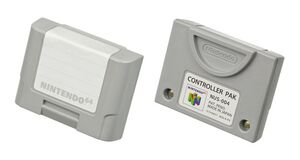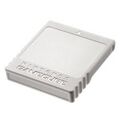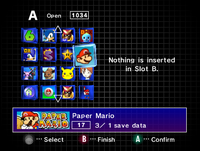| Site Notice |
|---|
|
We have a limited coverage policy. Please check our coverage page to see which articles are allowed. |
Difference between revisions of "Memory card"
Nintendo101 (talk | contribs) m (→References) |
Nintendo101 (talk | contribs) m |
||
| (One intermediate revision by the same user not shown) | |||
| Line 1: | Line 1: | ||
[[File:GCN Memory Card Screen.png|200px|thumb|Memory Card management screen for GameCube.]] | [[File:GCN Memory Card Screen.png|200px|thumb|Memory Card management screen for GameCube.]] | ||
| − | A '''memory card''' is a video game accessory that has been a part of many gaming consoles. Essentially, it is an external memory database where game data is saved. From [[Nintendo 64]] to [[Nintendo 3DS]], a non-standard measurement unit called a '''block''' (a '''page''' on the Nintendo 64) was used for memory card capacity by Nintendo and in the consoles' system settings, and the size of the unit increased between console generations, though consistently became 128 KB in size throughout the [[Wii]], [[Nintendo DSi]] and Nintendo 3DS.<ref> | + | A '''memory card''' is a video game accessory that has been a part of many gaming consoles. Essentially, it is an external memory database where game data is saved. From [[Nintendo 64]] to [[Nintendo 3DS]], a non-standard measurement unit called a '''block''' (a '''page''' on the Nintendo 64) was used for memory card capacity by Nintendo and in the consoles' system settings, and the size of the unit increased between console generations, though consistently became 128 KB in size throughout the [[Wii]], [[Nintendo DSi]] and Nintendo 3DS.<ref>Nintendo of America. "[https://en-americas-support.nintendo.com/app/answers/detail/a_id/2808/~/how-to-check-available-blocks-of-memory-on-the-wii How to Check Available Blocks of Memory on the Wii]". ''Nintendo Official Website''.</ref> Since the [[Wii U]], industry standard units like gigabytes and megabytes are used within the consoles' settings. |
==List of Memory cards== | ==List of Memory cards== | ||
| Line 12: | Line 12: | ||
===Nintendo GameCube=== | ===Nintendo GameCube=== | ||
[[File:Gamecube mcard.jpg|120px|thumb|A [[Nintendo GameCube]] memory card]] | [[File:Gamecube mcard.jpg|120px|thumb|A [[Nintendo GameCube]] memory card]] | ||
| − | Unlike the Nintendo 64, the [[Nintendo GameCube]] is very dependent on the memory card, since save data cannot be written on its discs, and the GameCube lacks any form of internal memory. Games played without the memory card inserted act as if they were being played for the first time, and data cannot be saved. Three types of memory cards were officially released, from lowest to highest storage and sporting color differentiation: the first type is gray and can store up to fifty-nine blocks (0.47 MB); the second is black and can store up to 251 (2.0 MB); and the third is white and can store up to 1,019 (8.1 MB). Nintendo of Europe lists the rate for GameCube memory cards as 59 blocks (4 MB),<ref> | + | Unlike the Nintendo 64, the [[Nintendo GameCube]] is very dependent on the memory card, since save data cannot be written on its discs, and the GameCube lacks any form of internal memory. Games played without the memory card inserted act as if they were being played for the first time, and data cannot be saved. Three types of memory cards were officially released, from lowest to highest storage and sporting color differentiation: the first type is gray and can store up to fifty-nine blocks (0.47 MB); the second is black and can store up to 251 (2.0 MB); and the third is white and can store up to 1,019 (8.1 MB). Nintendo of Europe lists the rate for GameCube memory cards as 59 blocks (4 MB),<ref>Nintendo of Europe. "[https://www.nintendo.com/en-gb/Support/Nintendo-GameCube/Accessories/Memory-Card-59/Memory-Card-59-619188.html Memory Card 59]." ''Nintendo Official Website''. Retrieved 9 May 2024.</ref> which would result in 66-70 KB per block; other sources contradict this, indicating that Nintendo of Europe mistakenly measured in megabytes instead of megabits, instead resulting in 7-8 KB per block. |
===SD Cards=== | ===SD Cards=== | ||
| Line 27: | Line 27: | ||
{{Nintendo 64}} | {{Nintendo 64}} | ||
{{Nintendo GameCube}} | {{Nintendo GameCube}} | ||
| + | |||
| + | [[Category:Accessories]] | ||
| + | [[Category:Media storage]] | ||
| + | [[Category:Nintendo GameCube Accessories]] | ||
Latest revision as of 03:18, 31 May 2024
A memory card is a video game accessory that has been a part of many gaming consoles. Essentially, it is an external memory database where game data is saved. From Nintendo 64 to Nintendo 3DS, a non-standard measurement unit called a block (a page on the Nintendo 64) was used for memory card capacity by Nintendo and in the consoles' system settings, and the size of the unit increased between console generations, though consistently became 128 KB in size throughout the Wii, Nintendo DSi and Nintendo 3DS.[1] Since the Wii U, industry standard units like gigabytes and megabytes are used within the consoles' settings.
Contents
List of Memory cards
Controller Pak

The Controller Pak (Japanese: コントローラパック) is an accessory for the Nintendo 64 and the first memory card for a Nintendo console. It plugs into the controller's accessory slot. Many games just use the Controller Pak for storing non-main game data, mainly since cartridges allow for data to be saved directly onto them. One Super Mario game to utilize this is Mario Kart 64, where all race data is saved onto the game, but Ghosts from time trials are saved onto the Controller Pak, where they take up either 121 (30.9 KB) or 123 (31.4 KB) blocks.
Most Controller Paks can only hold up to 123 pages (31.4 KB) of memory, and have 128 pages total (one page being 256 bytes), with the remaining 5 pages (1.2 KB) reserved for formatting purposes.
Nintendo GameCube

Unlike the Nintendo 64, the Nintendo GameCube is very dependent on the memory card, since save data cannot be written on its discs, and the GameCube lacks any form of internal memory. Games played without the memory card inserted act as if they were being played for the first time, and data cannot be saved. Three types of memory cards were officially released, from lowest to highest storage and sporting color differentiation: the first type is gray and can store up to fifty-nine blocks (0.47 MB); the second is black and can store up to 251 (2.0 MB); and the third is white and can store up to 1,019 (8.1 MB). Nintendo of Europe lists the rate for GameCube memory cards as 59 blocks (4 MB),[2] which would result in 66-70 KB per block; other sources contradict this, indicating that Nintendo of Europe mistakenly measured in megabytes instead of megabits, instead resulting in 7-8 KB per block.
SD Cards
| Main article: SD Card |
External links
References
- ↑ Nintendo of America. "How to Check Available Blocks of Memory on the Wii". Nintendo Official Website.
- ↑ Nintendo of Europe. "Memory Card 59." Nintendo Official Website. Retrieved 9 May 2024.
|
|
|
|


